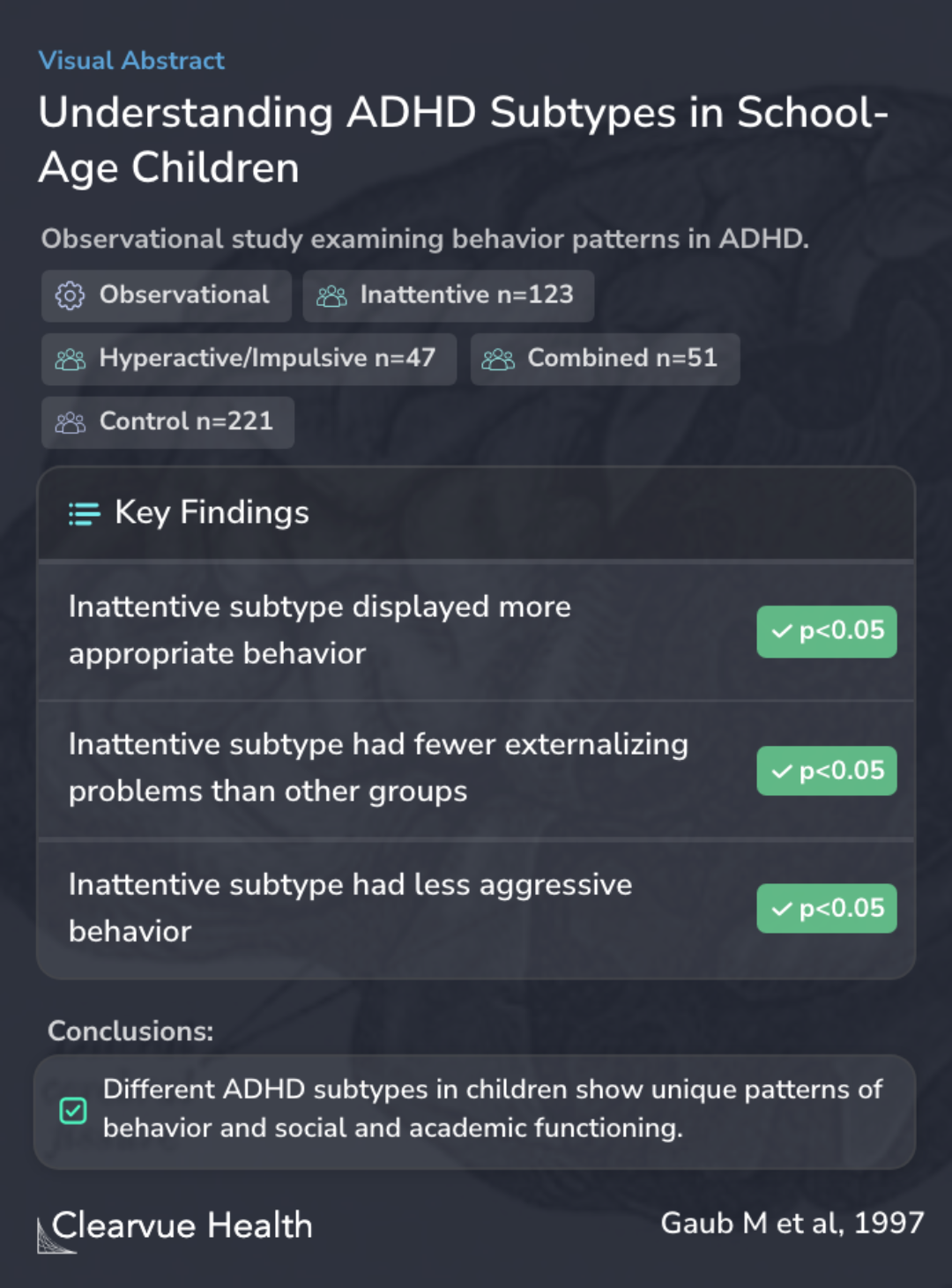Behavioral characteristics of DSM-IV ADHD subtypes in a school-based population
Understanding ADHD Subtypes in School-Age Children
Gaub M, Carlson CL

Objectives
The research aimed to understand different types of attention deficit hyperactivity disorder (ADHD) in children.
Methods
It focused on a diverse group of 2,744 school children, among whom 221 were identified with ADHD. These included 123 children with predominantly inattentive type ADHD, 47 with predominantly hyperactive/impulsive type, and 51 with the combined type. This study used teacher ratings based on a checklist from the Diagnostic and Statistical Manual of Mental Disorders, 4th edition (DSM-IV), to compare these children with 221 others who didn't have ADHD. The comparison looked at how the children behaved, their academic performance, and how they got along with others.
From an ethnically diverse sample of 2,744 school children, 221 attention deficit hyperactivity disorder (ADHD) [123 (4.5%) predominantly inattentive (IA), 47 (1.7%) predominantly hyperactive/impulsive (HI), and 51 (19%) combined type (C)] were identified using teacher ratings on a Diagn...
Results
In this study, the researchers discovered that each ADHD diagnostic group, whether inattentive, hyperactive/impulsive, or combined type, had its own unique challenges. Children with inattentive ADHD struggled in all areas but were generally better behaved and had fewer problems with acting out than those with other types of ADHD. On the other hand, children with hyperactive/impulsive ADHD had more issues with behavior and getting along with others, but they didn't differ much from the control group in learning or internal problems. Those with the combined type of ADHD faced significant difficulties across all areas.
The results revealed relatively independent areas of impairment for each diagnostic group. The IA children were impaired in all areas, but were rated as displaying more appropriate behavior and fewer externalizing problems than HI or C children. The HI group displayed externalizing and s...
Conclusions
These findings emphasize the distinct nature of each ADHD subtype. All groups with ADHD showed some problems compared to the control group, but the kinds of problems they had varied based on the type of ADHD. Children with the inattentive subtype, for example, showed more appropriate behavior and had fewer problems with aggressive behavior and acting out compared to the other groups.
These findings support the validity of the DSM-IV ADHD subtypes; all ADHD groups demonstrated impairment relative to controls, but show different patterns of behavioral characteristics.
Key Takeaways
Context
The nature of ADHD subtypes is dynamic, changing as individuals age. This phenomenon is critical in understanding ADHD's impact over a lifetime. Initially, a person might be diagnosed with hyperactive ADHD, but this can shift to a different subtype as they grow older. This evolution of ADHD subtypes is an important aspect of the disorder's complexity.
Research supports this notion of changeable subtypes. Studies indicate that adults diagnosed with ADHD often display symptoms more aligned with the inattentive subtype, rather than the hyperactive or combined subtypes more commonly identified in children. This shift in symptomatology highlights the necessity for continuous monitoring and adapting treatment approaches as individuals with ADHD transition from childhood to adulthood.
The understanding that ADHD symptoms and subtypes can evolve over time adds an essential layer to our comprehension of the disorder. It suggests that long-term studies and individualized treatment strategies are crucial for effectively managing ADHD across different life stages.